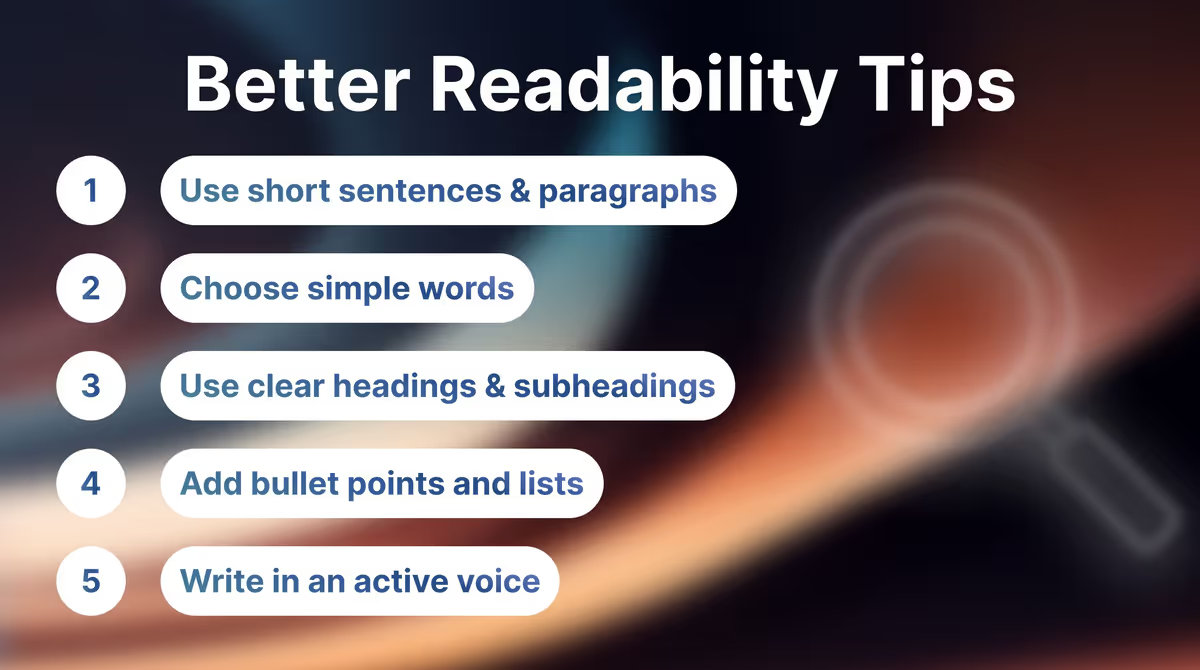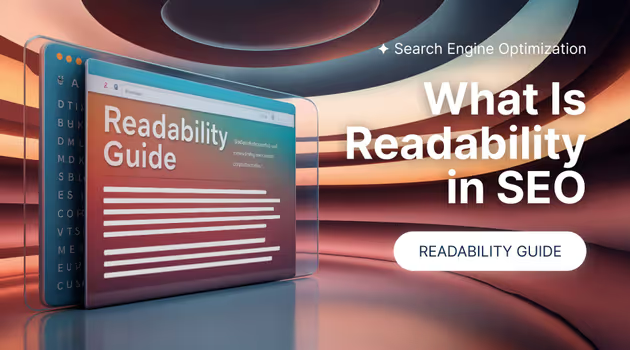What Is Readability in SEO?
When people visit your website, they want information quickly and easily. If your content is too complicated or hard to scan, visitors may leave—hurting both user experience and your SEO.
Search engines like Google favor pages that keep readers engaged, meaning readability plays a key role in rankings. But readability isn’t just about simple words; it’s about structuring content so that it flows naturally, making it effortless to digest.
Definition of Readability
Readability refers to how easily someone can read and understand your content. A well-structured, clear piece of writing keeps readers engaged, while complex or cluttered content can drive them away.
For example, a sentence with good readability:
✅ “Short sentences and simple words make reading easy and enjoyable.”
A sentence with poor readability:
❌ “The utilization of unnecessarily intricate terminology in an excessively convoluted sentence structure diminishes overall comprehension.”
The first is straightforward and engaging. The second is overly complex and difficult to process—something both readers and search engines dislike.
Why Readability Matters for SEO
Google and other search engines prioritize content that keeps users engaged. If your text is hard to read, visitors will leave quickly, increasing your bounce rate and signaling to Google that your page isn't useful.
According to a study by the NNGroup, users typically read only 20-28% of a webpage’s content, so making text skimmable improves retention.
Another report from Backlinko found that pages with a lower reading level tend to rank higher on Google. This means simple, clear writing isn’t just better for users—it directly impacts your SEO performance.
How to Identify Readability Issues on Your Website
Readability problems can seem trivial, but they can make all the difference. If your visitors are having a hard time comprehending your text, they'll leave in a hurry—leaving you with lower engagement, fewer conversions, and worst of all, worse rankings on Google.
A website with poor readability feels like a book with tiny, dense text and no chapter breaks—frustrating and exhausting. The good news? Readability problems are easy to spot if you know what to look for.
Signs of Poor Readability
Not sure if your content is hard to read? Here are some early warning signs:
- Visitors leave fast
If people click on your page but leave within seconds, they might be struggling to read or scan the content.
- Few people scroll down
If most visitors never get past the first few paragraphs, your content might be too dense or uninviting.
- Low engagement
If users rarely comment, share, or interact with your content, they may not find it easy to read or engaging.
- Frequent complaints or confusion
If people ask the same basic questions over and over, your content may not be clear enough.
Metrics to Check Readability
- Bounce Rate – A high bounce rate (when users leave quickly) can mean your content is too hard to read or not engaging enough. Check this in Google Analytics under Behavior > Site Content.
- Time on Page – If visitors spend only a few seconds on your page, it suggests they aren’t reading much. Longer time on page means better engagement.
- Scroll Depth – Tools like Google Tag Manager can show how far users scroll down a page. If most stop early, your content might not be inviting.
- Flesch-Kincaid Readability Score – This tool measures how easy your text is to read. Aim for a score of 60-70 for general web content (meaning 8th-9th grade reading level).
- Hemingway Editor & Grammarly – These tools highlight long sentences, passive voice, and complex words, helping to simplify your writing.
- Click-Through Rate (CTR) – A low CTR on search results might mean your page title and description aren’t clear or appealing enough.
Causes and Consequences of Poor Readability
Before you can fix a problem, you need to know what’s causing it. Readability issues don’t happen by accident—certain writing habits can make content harder to digest. And when readability suffers, so does your website’s performance.
Common Reasons for Poor Readability
- Long, complicated sentences – If a sentence drags on and on, readers lose track of the point.
Example: ❌ "In an ever-evolving digital landscape, businesses must continuously adapt their strategies to ensure the optimization of their online presence for enhanced engagement and increased conversions."
Better: ✅ "Businesses need to update their strategies to stay visible and attract customers online."
- Complex words and jargon – Industry-specific terms might impress experts but confuse most readers.
Example: ❌ "Our cutting-edge, AI-driven omnichannel marketing solutions leverage real-time analytics."
Better: ✅ "We use AI to improve marketing and track results instantly."
- Poor structure and lack of breaks – Walls of text without subheadings, bullet points, or spacing can overwhelm readers. If they can’t skim the content easily, they might leave.
Impact on SEO and User Engagement
- High Bounce Rate – If visitors struggle to read your content, they leave quickly. For example, a study by HubSpot found that pages with complex language had up to 58% higher bounce rates than simpler ones.
- Lower Search Rankings – Google tracks user behavior, and if people consistently leave your site fast, it signals low-quality content. This can push your rankings down.
- Fewer Conversions – If visitors can’t quickly understand your offer, they won’t take action. A poorly worded landing page might lose potential customers who don’t have time to decode it.
For example, imagine two online stores selling the same hat. One has a product description full of technical details, while the other simply says, "Lightweight, stylish, and perfect for sunny days." Which one do you think will sell more?
How to Improve Readability and Tools to Help
Writing readable content does not have to be difficult. With some simple changes, you can create text that is easy to read, engaging, and search engine-friendly.

Best Practices for Better Readability
Use short sentences and paragraphs
Break long ideas into bite-sized pieces to keep readers engaged.
- ❌ "The marketing team conducted an in-depth analysis of consumer behavior, identifying key trends and patterns that could potentially influence future sales strategies while also considering external market factors."
- ✅ "The marketing team studied consumer behavior. They identified trends that could shape future sales strategies."
Choose simple words
Avoid jargon and complicated terms when a simpler alternative works.
- ❌ "Our platform utilizes a multifaceted approach to facilitate seamless omnichannel customer interactions."
- ✅ "Our platform makes it easy for customers to connect across different channels."
Use clear headings and subheadings
Guide readers so they can easily find what they need.
- ❌ "Comprehensive Insights into Effective Content Marketing Strategies for Business Expansion and Customer Acquisition"
- ✅ "How Content Marketing Helps Your Business Grow"
Add bullet points and lists
They make information easier to digest.
- ❌ A long, unstructured paragraph listing multiple points:
To create engaging content, focus on writing clearly, using visuals, adding relevant examples, keeping paragraphs short, and using an active voice. - ✅ A clean, skimmable bullet list:
- Write clearly and concisely
- Use visuals to break up text
- Add relevant examples
- Keep paragraphs short
- Use an active voice
Write in an active voice
Sentences feel clearer and more direct.
- ❌ "The website was redesigned by the team to improve user experience."
- ✅ "The team redesigned the website to improve user experience."
Readability Tools You Can Use
- Hemingway Editor – Highlights long, complex sentences and suggests simpler alternatives. (Free version available)
- Grammarly – Checks for grammar, clarity, and readability issues. (Free version available)
- Yoast SEO – If you use WordPress, this plugin gives readability scores and SEO suggestions. (Free version available)
- Readable – Offers detailed readability scoring and keyword analysis. (Paid tool, with a free trial)
- Microsoft Word & Google Docs – Built-in readability tools like Flesch-Kincaid scores help gauge complexity. (Free with a Google account for Docs, Word requires Office subscription)
- ProWritingAid – A writing assistant that checks readability, style, and grammar for better clarity. (Free version available)
- Slick Write – Identifies overused words, complex sentences, and grammar mistakes. (Free to use)
- Gunning Fog Index – Measures the complexity of text based on sentence length and word difficulty. (Free to use)
- Linguix – Provides AI-powered readability enhancements and style suggestions. (Paid tool, with a free trial)

